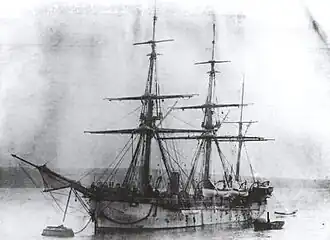HMS Albatross (1873)
 HMS Albatross's sister ship, HMS Egeria
| |
| History | |
|---|---|
| Name | HMS Albatross |
| Namesake | Albatross |
| Builder | Chatham Royal Dockyard |
| Laid down | 1872 |
| Launched | 27 April 1873 |
| Completed | February 1874 |
| Fate | Scrapped, February 1889 |
| General characteristics | |
| Class & type | Fantome-class sloop |
| Displacement | 949 long tons (964 t) |
| Tons burthen | 727 bm |
| Length | 160 ft (48.8 m) (p/p) |
| Beam | 31 ft 4 in (9.6 m) |
| Draught | 14 ft (4.3 m) |
| Depth | 15 ft 6 in (4.7 m) |
| Installed power | 838 ihp (625 kW) |
| Propulsion |
|
| Sail plan | Barque rig |
| Speed | 10 knots (19 km/h; 12 mph) |
| Range | 1,000 nmi (1,900 km; 1,200 mi) at 10 knots (19 km/h; 12 mph) |
| Complement | 125 |
| Armament |
|
HMS Albatross was a 4-gun Fantome-class sloop built for the Royal Navy in the mid-1870s.
History
In May 1886, she was driven ashore at Hong Kong whilst going to the assistance of the British ship Dafila, which had also driven ashore.[1] Both vessels were refloated, and HMS Albatross towed Dafila in to Hoikow, China.[2]
Figurehead
This carving is not a true figurehead but a scroll designed for a sloop’s vertical bow.
In seafaring folklore, the albatross is often seen as a good omen, believed to be the souls of sailors lost at sea. The birds are excellent navigators, using ocean winds to navigate the high seas; by observing an albatross in flight, some sailors were able to adjust the course of their ship to avoid hazardous conditions.[3]
The albatross, however, may also be seen as a harbinger of misfortune to sailors.[4] This is largely owed to Samuel Taylor Coleridge’s 1798 poem, ‘The Rime of the Ancient Mariner’, in which a sailor kills an albatross, bringing a curse upon the ship and its crew:
'God save thee, ancient Mariner!
From the fiends, that plague thee thus!—
Why look'st thou so?'—With my cross-bow
I shot the ALBATROSS.
…
And every tongue, through utter drought,
Was withered at the root;
We could not speak, no more than if
We had been choked with soot.
Ah! well a-day! what evil looks
Had I from old and young!
Instead of the cross, the Albatross
About my neck was hung.[5]
As the poem unfolds, a ghost ship appears to the ancient mariner foretelling the death of his crew. He is cursed and forced to wander the world telling his tale as a warning. He eventually finds redemption after experiencing a moment of reverence for nature.
The carving was still at Chatham Dockyard in 1938 but 11 years later, it had been moved to HMS Ganges, a boys’ training establishment at Shotley, Suffolk. This establishment closed in 1984 and the carving was transferred to the collections of the then Royal Naval Museum.[6]
The carving can be seen in the Figureheads Gallery at the National Museum of the Royal Navy, Portsmouth.[7] It can also be viewed alongside other figureheads within the collection on the Bloomberg Connects website[1] and app.
Notes
- ^ "Latest Shipping Intelligence". The Times. No. 31762. London. 18 May 1886. col F, p. 10.
- ^ "Latest Shipping Intelligence". The Times. No. 31763. London. 19 May 1886. col E, p. 12.
- ^ "Albatrosses: Inspiring Legends & Myths". BirdLife International. 19 June 2023. Retrieved 14 July 2025.
- ^ "National Maritime Museum Cornwall | National Maritime Museum Cornwall". NMMC. 18 October 2019. Archived from the original on 11 July 2025. Retrieved 14 July 2025.
- ^ "The Rime of the Ancient Mariner (text of 1834)". The Poetry Foundation. 13 March 2020. Retrieved 14 July 2025.
- ^ Pulvertaft, David (2009). The Warship Figureheads of Portsmouth (1st Colour ed.). UK: The History Press. p. 105. ISBN 978-0752450766.
- ^ "Discover the Royal Navy like never before | National Museum of the Royal Navy". www.nmrn.org.uk. Retrieved 14 July 2025.
Bibliography
- Ballard, G. A. (1939). "British Sloops of 1875: The Smaller Composite Type". Mariner's Mirror. 25 (April). Society for Nautical Research: 151–61.
- Colledge, J. J.; Wardlow, Ben & Bush, Steve (2020). Ships of the Royal Navy: The Complete Record of All Fighting Ships of the Royal Navy from the 15th Century to the Present (5th ed.). Seaforth Publishing. ISBN 978-1-5267-9327-0.
- Roberts, John (1979). "Great Britain and Empire Forces". In Chesneau, Roger & Kolesnik, Eugene M. (eds.). Conway's All the World's Fighting Ships 1860-1905. Conway Maritime Press. ISBN 0-8317-0302-4.
- Winfield, R.; Lyon, D. (2004). The Sail and Steam Navy List: All the Ships of the Royal Navy 1815–1889. London: Chatham Publishing. ISBN 978-1-86176-032-6. OCLC 52620555.